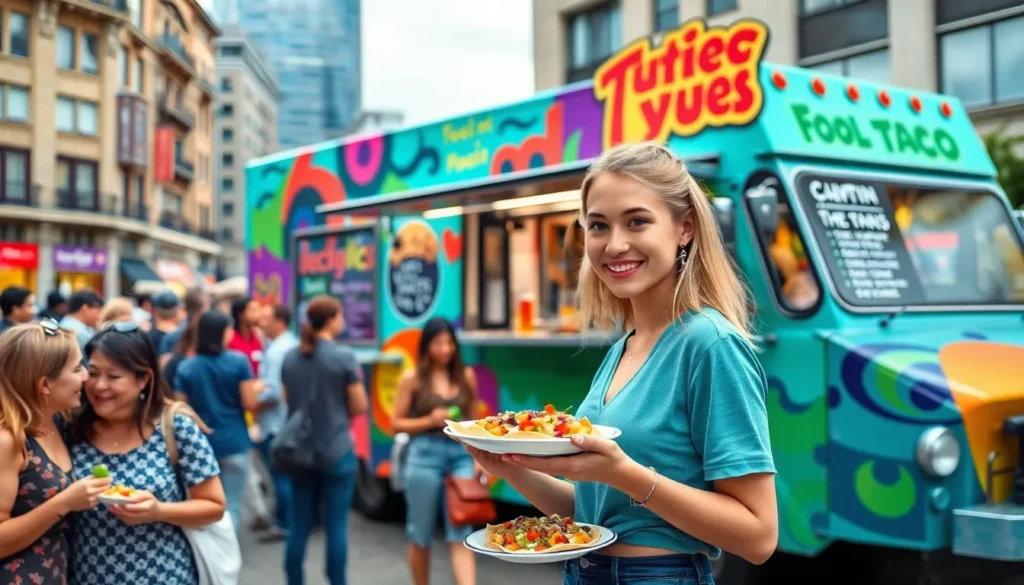In a world where kale chips can be as trendy as a gourmet burger, the food and beverage industry never stops evolving. From plant-based wonders to sustainable packaging, today’s consumers crave innovation and flavor like never before. It’s not just about what’s on the plate; it’s about the experience that comes with it.
Table of Contents
ToggleOverview of Latest Trends in Food and Beverage Industry
The food and beverage industry continues to experience dynamic changes driven by consumer preferences. Increased interest in plant-based products reflects a significant shift toward healthier lifestyles. Consumers demand transparency, which leads brands to disclose sourcing information and ingredient lists.
Sustainable packaging initiatives gain momentum, aligning with environmental concerns. Biodegradable and recyclable options become more prevalent as companies aim to reduce their carbon footprint. Moreover, companies are exploring innovative packaging solutions that minimize waste.
An emphasis on experiential dining enhances customer engagement. Restaurants now curate unique experiences, from themed menus to immersive settings. Experiential aspects cater to the desire for memorable outings, encouraging repeat visits.
Technology integration influences purchasing habits. The rise of food delivery apps shifts how consumers access meals. With contactless dining solutions, restaurants enhance convenience without compromising safety.
Craft beverages, including specialty coffees and artisanal spirits, attract attention. Local producers gain popularity, promoting a sense of community through unique flavors. Craft beverages satisfy the growing demand for authentic experiences.
Health-conscious consumption leads to innovative product formulations. Brands craft low-sugar, high-protein, and functional foods, attracting health-focused consumers. Functional beverages that promote wellness, such as those containing adaptogens or probiotics, also gain traction.
Trends in the food and beverage industry reflect evolving consumer expectations. A focus on health, sustainability, and experience shapes product offerings and dining environments. Understanding these trends is vital for businesses aiming to thrive in a competitive market.
Health and Wellness Innovations
Health and wellness trends significantly shape the food and beverage industry. Increased awareness of health effects drives these changes.
Plant-Based Alternatives
Plant-based alternatives gain traction among consumers seeking healthier options. Many brands now offer meat substitutes made from pea protein, soy, and lentils. These products cater to flexitarians, vegetarians, and vegans alike, combining taste and nutritional benefits. Consumer interest extends to plant-based dairy products, including almond, oat, and coconut milk. In 2022, the plant-based food market reached $7 billion, reflecting a growing demand for sustainable choices. Innovative companies continue to develop realistic meat textures and flavors, making plant-based options more appealing.
Clean Label Products
Clean label products emphasize transparency and simplicity in ingredients. Today’s consumers prefer foods with no artificial additives or preservatives. The push for clean labels has led to demand for organic, non-GMO, and locally sourced ingredients. Brands often highlight minimal processing in their marketing efforts. A survey showed that 59% of consumers check labels for familiar ingredients before purchasing. This movement drives brands to reformulate existing products while maintaining flavor and quality. Trust and authenticity emerge as crucial factors in consumers’ purchasing decisions.
Sustainability Practices
Sustainability practices in the food and beverage industry are gaining traction as businesses respond to consumer demands for environmental responsibility. Companies increasingly prioritize eco-friendly solutions while enhancing their brand image.
Eco-Friendly Packaging
Eco-friendly packaging options play a crucial role in sustainability initiatives. Brands implement biodegradable materials, compostable containers, and recyclable alternatives to minimize waste. In 2022, the global sustainable packaging market was valued at $472 billion, showcasing a robust shift towards greener solutions. Many companies focus on reducing plastic use by adopting innovative designs that maintain product integrity without harming the environment. Notably, the food delivery sector has seen a surge in sustainable packaging solutions, enhancing convenience while adhering to eco-friendly standards.
Waste Reduction Strategies
Waste reduction strategies emerge as a vital aspect of sustainability practices. Restaurants and food manufacturers adopt practices like ingredient optimization, energy-efficient processes, and surplus food donation. Implementing these strategies can significantly cut food waste, with approximately 30% of food produced globally wasted annually. Many businesses now measure waste streams to identify areas for improvement and set measurable reduction goals. Innovative methods, like upcycling food scraps into new products, also gain popularity as brands strive for zero waste, aligning with consumer preferences for sustainability.
Technological Advancements
Technological advancements significantly impact the food and beverage industry, reshaping how consumers experience food. Innovations streamline processes, enhance convenience, and improve consumer engagement.
Smart Food Technologies
Smart food technologies boost efficiency and quality in food production. Automated systems in processing reduce labor costs while increasing food safety. Internet of Things (IoT) devices allow for real-time monitoring of temperature and humidity, ensuring optimal conditions in storage and transport. Artificial intelligence analyzes consumer preferences, aiding brands in developing tailored products. The implementation of blockchain technology enhances transparency, allowing consumers to trace product origins. These advancements respond to the growing demand for reliable and sustainable food sources.
Online Ordering and Delivery Trends
Online ordering and delivery trends continue to evolve, driven by consumer preference for convenience. Food apps streamline the ordering experience, providing users with a broader range of dining options. Statistics show that the online food delivery market was valued at $151 billion in 2021, demonstrating significant growth. Additionally, contactless payment methods enhance safety and efficiency during transactions. Subscription meal services cater to busy lifestyles, offering curated meal kits that save time. With these changes, brands adapt to shifting consumer behaviors, ensuring they stay competitive in a rapidly changing market.
Consumer Preferences
Consumer preferences in the food and beverage industry reflect a desire for personalization and unique experiences.
Personalized Dining Experiences
Restaurants emphasize creating personalized dining experiences that resonate with individual tastes. Chefs often customize menus based on dietary restrictions or seasonal ingredients to cater to diverse palates. Interactive dining formats, such as build-your-own dishes, engage customers and foster a sense of ownership over their meals. Moreover, exclusive events, like wine pairings or chef’s table experiences, enhance connection between diners and culinary creators. A significant 70% of consumers express interest in personalization, highlighting the effectiveness of tailored experiences in improving customer loyalty. Data shows that brands that focus on personalization enjoy higher levels of consumer satisfaction.
Global Flavors and Fusion Cuisine
A surge in interest for global flavors and fusion cuisine captures the imagination of adventurous eaters. Traditional dishes combined with innovative cooking techniques create vibrant and unique flavor profiles. Ingredients from one culture seamlessly blend with dishes from another, yielding exciting culinary hybrids. Close to 60% of consumers actively seek out diverse international cuisines, which reflects a keen curiosity about global food traditions. This trend drives chefs to explore and experiment with various flavor pairings, offering customers experiences that are both familiar and new. The growing appreciation for diverse culinary elements encourages restaurants to continuously adjust their menus, ensuring they keep up with evolving tastes.
The food and beverage industry is undergoing a remarkable transformation driven by evolving consumer preferences. Emphasis on health sustainability and technology is reshaping how businesses operate and engage with customers. As consumers seek more personalized and authentic experiences they’re influencing brands to innovate continuously.
The rise of plant-based options clean labeling and eco-friendly packaging reflects a collective shift toward responsible consumption. Additionally the integration of technology enhances convenience and transparency ensuring that businesses remain competitive.
Staying attuned to these trends is essential for companies looking to thrive in this dynamic market. Embracing change while prioritizing customer needs will define success in the food and beverage landscape of the future.






